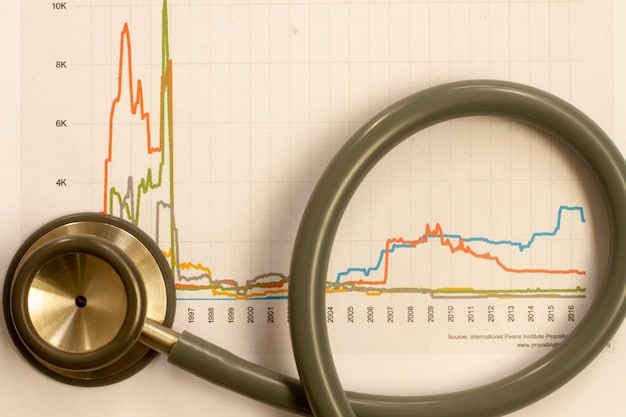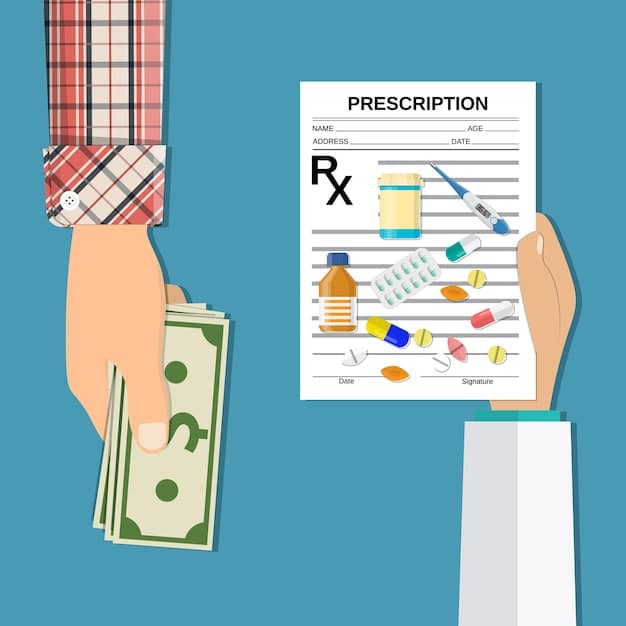Evaluating Medicare Part D Changes in 2025: A Fact Check

Evaluating the Accuracy of Claims Regarding Changes to Medicare Part D Prescription Drug Costs in 2025 involves scrutinizing statements about potential cost savings, benefit expansions, and premium adjustments to ensure beneficiaries receive reliable information for making informed healthcare decisions.
Navigating healthcare costs can be complex, especially when it comes to prescription drug coverage under Medicare Part D. Let’s embark on evaluating the accuracy of claims regarding changes to Medicare Part D prescription drug costs in 2025, ensuring clarity amidst potential misinformation.
Understanding Medicare Part D and Its Current Structure
Medicare Part D offers prescription drug coverage to Medicare beneficiaries. Understanding how it currently works is crucial before analyzing any proposed changes.
The basic structure involves premiums, deductibles, cost-sharing (copays or coinsurance), and a coverage gap (also known as the “donut hole”). Each of these elements affects how much a beneficiary pays out-of-pocket for their medications.
Key Components of Medicare Part D
Medicare Part D plans are offered by private companies that have been approved by Medicare. These plans vary in terms of covered drugs (formularies), cost-sharing structures, and pharmacy networks. Beneficiaries choose a plan that best suits their individual needs and preferences.
The “donut hole” has been a particularly controversial aspect of Medicare Part D, where beneficiaries used to pay a higher percentage of their drug costs after a certain spending threshold. While the Affordable Care Act has gradually closed this gap, understanding its historical impact is still relevant.

To fully grasp the potential impact of the 2025 changes, it is essential to understand the existing framework of Medicare Part D. This includes understanding the different phases of coverage and its associated costs:
- Premiums: The monthly fee you pay to be enrolled in a Medicare Part D plan.
- Deductible: The amount you pay out-of-pocket before your plan starts to pay its share.
- Cost-Sharing: This includes copayments (a fixed amount) or coinsurance (a percentage of the drug cost) that you pay for each prescription.
Understanding these core elements provides a solid foundation for evaluating the accuracy of claims about impending changes.
Overview of the 2025 Changes to Medicare Part D
Significant changes to Medicare Part D are slated to take effect in 2025. These changes aim to lower prescription drug costs and improve access to medications for beneficiaries.
These reforms are primarily a result of the Inflation Reduction Act, which includes provisions designed to reshape the landscape of prescription drug pricing and coverage under Medicare.
Key Provisions of the Inflation Reduction Act Affecting Medicare Part D
The most notable changes include a cap on out-of-pocket spending, government negotiation of drug prices, and modifications to the cost-sharing structure. These changes are expected to have a wide-ranging impact on beneficiaries, plan sponsors, and pharmaceutical companies.
These adjustments intend to alleviate some of the financial burdens on seniors and individuals with disabilities who rely on prescription medications. The goal is to offer more predictable and affordable drug costs.
- Out-of-Pocket Cap: A significant change is the implementation of an annual out-of-pocket spending cap for Part D beneficiaries.
- Drug Price Negotiation: The government will be able to negotiate prices for some of the most expensive drugs covered by Medicare.
- Cost-Sharing Changes: The structure of cost-sharing will be adjusted, affecting how much beneficiaries pay at different stages of coverage.
These overhauls are significant and require detailed examination to evaluate the accuracy of claims related to their impact.
Analyzing Claims of Reduced Prescription Drug Costs
Many claims suggest that the 2025 changes will substantially reduce prescription drug costs for Medicare Part D beneficiaries. A thorough examination of these claims is necessary.
It’s important to assess which beneficiaries are most likely to benefit from these changes and to what extent their costs will be reduced. Factors such as income level, medication needs, and choice of plan can all influence the actual impact.
Who Benefits Most?
Beneficiaries who take high-cost medications or have chronic conditions requiring multiple prescriptions are expected to see the most significant savings. The out-of-pocket cap will protect them from catastrophic drug costs.
However, not all beneficiaries will experience the same level of savings. Those with modest medication needs may see a smaller impact. Therefore, generalized claims need to be evaluated carefully.

When attempting to evaluate the accuracy of claims about reduced prescription costs, take these aspects into consideration:
- Out-of-Pocket Cap Effectiveness: Evaluate how the out-of-pocket cap will benefit those with high drug costs versus those with lower expenses.
- Negotiated Drug Prices Impact: Analyze the impact of government-negotiated drug prices on reducing costs overall and for specific medications.
- Plan Variations: Consider how different Part D plans may offer varying benefits and cost-sharing structures that influence overall expenses.
The claims should be grounded in individual circumstances rather than broad generalizations.
Evaluating the Impact on Premiums and Plan Choices
Another consideration is how these changes might affect Medicare Part D premiums and the choices beneficiaries make when selecting a plan. These aspects are crucial to understanding the full picture.
While the changes aim to lower out-of-pocket costs, some worry that they could lead to higher premiums or reduced plan options. It is important to analyze whether these concerns are justified.
Potential Trade-offs
The financial impact on plan sponsors is a key factor. If their costs increase due to the new regulations, they may pass those costs on to beneficiaries through higher premiums or by reducing the scope of their formularies.
It’s also possible that some plans will choose to exit the Medicare Part D market altogether, limiting the choices available to beneficiaries. Analyzing these potential trade-offs is an important part of evaluating the accuracy of claims.
Key factors to consider include:
- Premium Fluctuations: How Part D premiums might change due to cost-sharing adjustments.
- Plan Availability: The potential impact on the range of plan choices available to beneficiaries.
- Formulary Changes: The effect on drug formularies and whether specific medications will remain covered.
Examining these factors can help provide a more informed assessment.
Assessing the Role of Government Drug Price Negotiation
A cornerstone of the 2025 changes is allowing the government to negotiate drug prices with pharmaceutical companies. Its impact on lowering costs and improving access is of extreme significance.
This provision of the Inflation Reduction Act aims to reduce the prices of some of the most expensive drugs covered by Medicare. By negotiating directly, the government hopes to secure lower prices for beneficiaries.
Potential Benefits and Challenges
The extent to which drug price negotiation will lower costs depends on several factors, including the number of drugs subject to negotiation and the willingness of pharmaceutical companies to offer discounts. There is also debate about how this might affect pharmaceutical innovation.
Critics argue that government negotiation could stifle the development of new drugs. Weighing the potential benefits against these concerns is part of evaluating the accuracy of claims.
When assessing the relevance of government drug price negotiation, focus on:
- Scope of Negotiation: The number and types of drugs subjected to negotiation, and how this impacts costs.
- Impact on Innovation: How drug price negotiation may affect pharmaceutical innovation and patient access to new treatments.
- Overall Cost Savings: The extent to which drug price negotiation will reduce total prescription drug spending for Medicare.
A thorough understanding of these considerations is essential.
Verifying Claims About Improved Access to Medications
Beyond cost savings, some claims focus on how the 2025 changes will improve access to medications for Medicare Part D beneficiaries. Validating these statements is crucial.
Improved access could mean more comprehensive formularies, lower cost-sharing for certain medications, or expanded coverage for specific populations. It is important to determine whether these changes will genuinely broaden access to necessary treatments.
Addressing Barriers to Access
One potential benefit is that lower out-of-pocket costs could make it easier for beneficiaries to afford their medications. Additionally, changes to the cost-sharing structure could reduce the financial burden at different stages of coverage.
However, access is not solely about affordability. It also involves the availability of medications within a plan’s formulary and the ease of obtaining prescriptions. Evaluating the accuracy of claims requires consideration of these factors.
When examining claims about improved access to medications, analyze:
- Formulary Coverage: How the availability of drugs will change and if this ensures beneficiaries have the medications they need.
- Cost-Sharing Impact: How cost-sharing adjustments will reduce financial barriers at different coverage stages.
- Geographic Access: How the changes impact access for beneficiaries in rural or underserved areas.
These variables are pivotal in determining the actual impact.
| Key Aspect | Brief Description |
|---|---|
| 💰 Out-of-Pocket Cap | Annual cap on Part D spending to protect against high drug costs. |
| 💊 Drug Price Negotiation | Government negotiates prices for some high-cost drugs with manufacturers. |
| 📊 Cost-Sharing Changes | Adjustments to how beneficiaries share costs in different coverage stages. |
| ✅ Improved Access | Expanded coverage and lower costs that aim to improve access to medications. |
Frequently Asked Questions (FAQ)
▼
The primary goal is to lower prescription drug costs for beneficiaries while improving access to needed medications through measures like government negotiation and cost-sharing adjustments.
▼
The out-of-pocket cap will protect beneficiaries from high drug costs by setting an annual limit on their spending. Once reached, Medicare covers the remaining costs.
▼
Yes, all Medicare Part D plans will be affected by the 2025 changes. Adjustments will be mandated to ensure plan compliance with legal reforms, particularly on pricing and cost-sharing.
▼
Government negotiation allows Medicare to negotiate directly with drug manufacturers, aiming to secure lower prices for some of the most expensive prescription drugs for beneficiaries.
▼
Beneficiaries should review their current plan, understand how the changes will affect their specific medication costs, and explore other plan options to maximize benefits and cost savings.
Conclusion
Evaluating the accuracy of claims regarding changes to Medicare Part D prescription drug costs in 2025 requires a detailed analysis of the various elements, including cost savings, plan choices, drug price negotiation, and access to medications. By staying informed and critically assessing available information, beneficiaries can make well-informed decisions to optimize their healthcare coverage and manage their prescription drug expenses effectively.





